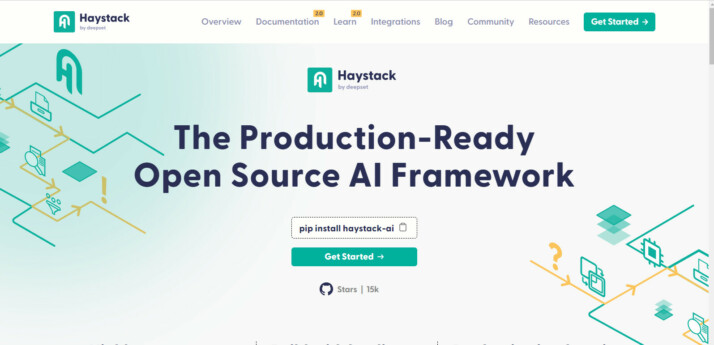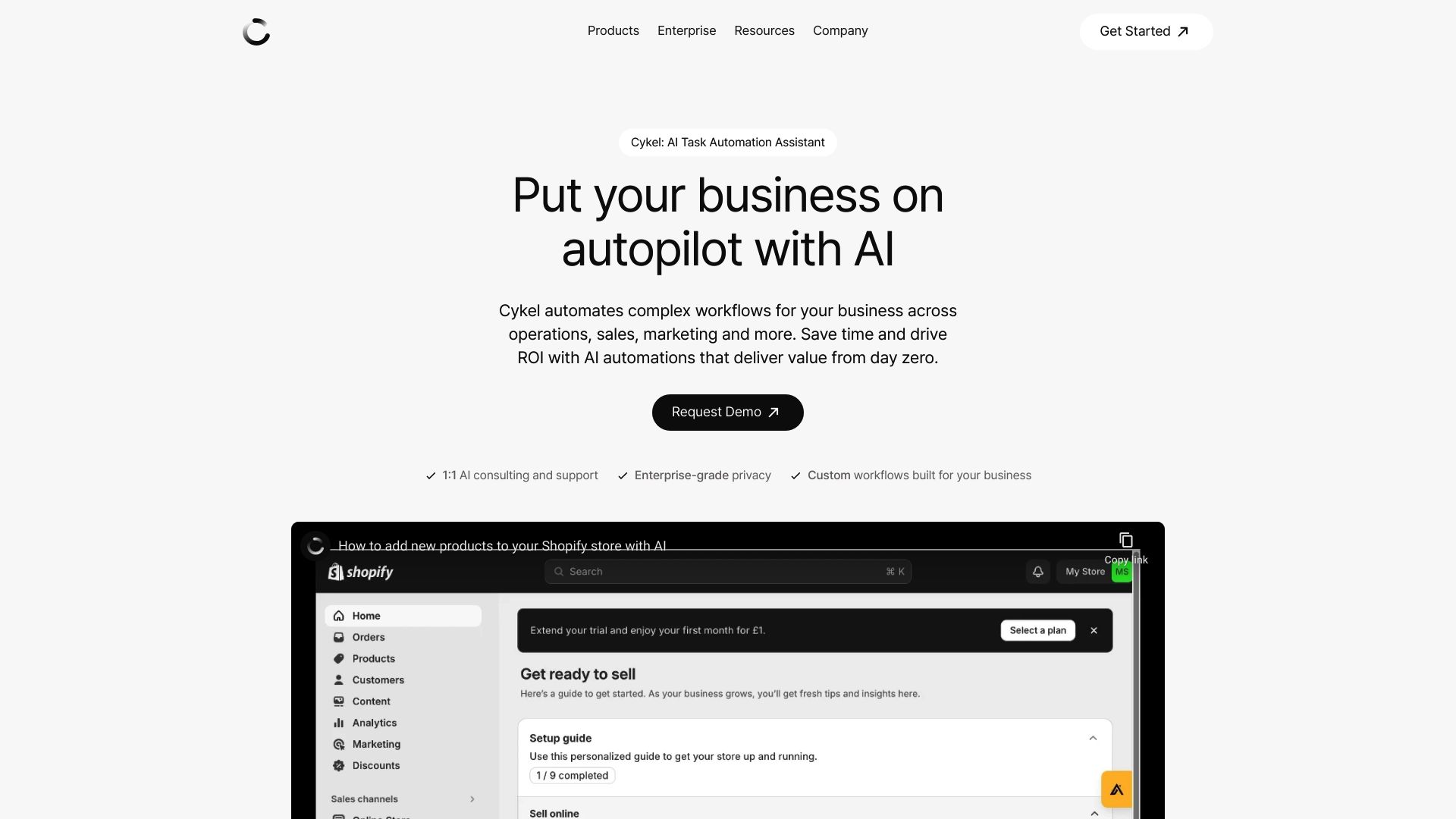Haystack vs. Cykel AI: Comparing AI Development Platforms
AI agent development platforms are transforming how businesses automate tasks and leverage language models. Haystack, an open-source framework, empowers developers to build sophisticated NLP applications. Cykel AI focuses on task automation for non-technical users. SmythOS combines powerful development tools with user-friendly interfaces, offering a comprehensive solution for AI agent creation and deployment. This comparison explores how each platform tackles AI development, highlighting their strengths in areas like customization, ease of use, and integration capabilities. We’ll examine key features, security measures, and overall suitability for different user groups, from developers to business professionals. By understanding these platforms’ unique approaches, you’ll gain insights to choose the best AI solution for your organization’s needs.
Haystack Overview
Haystack empowers developers to build production-ready applications using Large Language Models (LLMs) and vector search. This open-source framework excels in retrieval-augmented generation, document search, and question answering tasks.
Haystack’s modular architecture allows developers to create custom search experiences and conversational chatbots by integrating tools like Hugging Face Transformers, Elasticsearch, and OpenAI into flexible pipelines. Its end-to-end approach supports the full lifecycle of NLP application development, from prototyping to production deployment.


Haystack’s modular architecture allows developers to create custom search experiences and conversational chatbots by integrating tools like Hugging Face Transformers, Elasticsearch, and OpenAI into flexible pipelines.
Key features include AI agents that can use tools to resolve complex queries, support for multimodal retrieval of texts and tables, and integration with various foundational AI models. Haystack also offers explainable AI outputs and debugging capabilities for troubleshooting.
While Haystack provides powerful tools for developers, it lacks a visual builder or no-code editor, potentially limiting accessibility for non-technical users. The framework focuses on code-based interactions, which may require a steeper learning curve for some teams.
Haystack integrates seamlessly with popular APIs and services, enhancing its versatility. The platform supports deployment as APIs and webhooks, enabling easy integration into existing workflows. However, it doesn’t offer specific features for staging domains or scheduled agent deployment, which could impact certain use cases.
In the competitive landscape of AI development tools, Haystack stands out for its flexibility and robust support for advanced NLP tasks. Its open-source nature and integration capabilities make it attractive for developers seeking customizable solutions. However, teams requiring more visual development tools or extensive no-code options may need to explore alternative platforms.
Cykel AI Overview
Cykel AI revolutionizes task automation with its innovative AI assistant. This platform empowers users to effortlessly manage repetitive digital tasks across various industries. Cykel AI’s Task Operating System, launched in December 2023, integrates seamlessly with existing systems, allowing users to automate complex workflows through simple language instructions.
The platform excels in proactive task automation, enabling AI agents to act autonomously based on user directives. This capability sets Cykel AI apart, functioning as the ’hands’ to complement the ’brain’ of traditional AI systems. Users can automate tasks such as data entry, lead generation, email management, and CRM updates without requiring technical expertise.
Cykel AI revolutionizes task automation with its innovative AI assistant. This platform empowers users to effortlessly manage repetitive digital tasks across various industries.
Cykel AI offers universal integration, working with multiple web apps and websites to serve as a personal AI assistant. Its browser control feature stores personal details and website-specific instructions, streamlining task completion across various digital platforms. This versatility makes Cykel AI valuable in fields ranging from sales and marketing to finance and customer service.


While Cykel AI offers powerful automation capabilities, it lacks some features found in more comprehensive AI development platforms. The system does not provide a visual builder or no-code editor, which may limit accessibility for non-technical users. Additionally, there’s no mention of specific features for agent work scheduling or data lake support.
Cykel AI’s vision focuses on improving business processes by automating mundane digital tasks, allowing users to concentrate on more meaningful work. The company aims to expand its presence in the UK, Europe, and North America, building strategic partnerships to drive broader AI adoption. As Cykel AI continues to evolve, it has the potential to significantly transform how businesses operate, enhancing overall work efficiency across various sectors.
Feature Comparison
Haystack and Cykel AI offer distinct approaches to AI agent development, with key differences in their core components and security features. Haystack provides a robust open-source framework for building production-ready NLP applications, while Cykel AI focuses on task automation through its AI assistant.
In terms of core components, Haystack excels with its modular architecture, allowing developers to create custom search experiences and conversational chatbots by integrating various tools and models. It supports multimodal retrieval and offers explainable AI outputs. Cykel AI, on the other hand, emphasizes proactive task automation across multiple web apps and websites, functioning as a personal AI assistant without requiring coding expertise.
Security features present a notable gap between the two platforms. Haystack integrates with deepset Cloud, likely offering data encryption and OAuth support for enterprise deployments. Cykel AI’s documentation does not explicitly mention advanced security features like constrained alignment or IP control, which may be a concern for businesses handling sensitive data.
While both platforms support AI agents and autonomous operations, Haystack provides more extensive tools for developers, including debug modes and integration with foundation AI models. Cykel AI focuses on accessibility for non-technical users, offering browser control and universal integration with various web applications. This difference in approach may influence the choice for organizations based on their technical expertise and specific use cases.
Feature Comparison Table
| Haystack | Cykel AI | SmythOS | |
|---|---|---|---|
| CORE FEATURES | |||
| Hosted Agents (Dev, Production) | ✅ | ❌ | ✅ |
| Visual Builder | ❌ | ❌ | ✅ |
| No-Code Options | ❌ | ✅ | ✅ |
| Explainability & Transparency | ✅ | ❌ | ✅ |
| Debug Tools | ✅ | ❌ | ✅ |
| Multimodal | ✅ | ❌ | ✅ |
| Multi-Agent Collaboration | ✅ | ❌ | ✅ |
| Audit Logs for Analytics | ✅ | ❌ | ✅ |
| Agent Work Scheduler | ❌ | ✅ | ✅ |
| Logs & Monitoring | ✅ | ❌ | ✅ |
| SECURITY | |||
| Constrained Alignment | ❌ | ❌ | ✅ |
| Data Encryption | ✅ | ❌ | ✅ |
| OAuth | ✅ | ❌ | ✅ |
| IP Control | ❌ | ❌ | ✅ |
| COMPONENTS | |||
| Foundation AIs | ✅ | ❌ | ✅ |
| Huggingface AIs | ✅ | ❌ | ✅ |
| Zapier APIs | ❌ | ❌ | ✅ |
| Classifiers | ✅ | ❌ | ✅ |
| Data Lakes | ❌ | ❌ | ✅ |
| DEPLOYMENT OPTIONS (EMBODIMENTS) | |||
| Deploy as API | ✅ | ❌ | ✅ |
| Deploy as Webhook | ✅ | ❌ | ✅ |
| Staging Domains | ❌ | ❌ | ✅ |
| Production Domains | ❌ | ✅ | ✅ |
| API Authentication (OAuth + Key) | ✅ | ❌ | ✅ |
| Deploy as Site Chat | ✅ | ❌ | ✅ |
| Deploy as Scheduled Agent | ❌ | ✅ | ✅ |
| Deploy as GPT | ✅ | ❌ | ✅ |
| DATA LAKE SUPPORT | |||
| Hosted Vector Database | ✅ | ❌ | ✅ |
| Sitemap Crawler | ❌ | ❌ | ✅ |
| YouTube Transcript Crawler | ❌ | ❌ | ✅ |
| URL Crawler | ✅ | ❌ | ✅ |
| PDF Support | ✅ | ❌ | ✅ |
| Word File Support | ✅ | ❌ | ✅ |
| TXT File Support | ✅ | ❌ | ✅ |
Best Alternative to Haystack and Cykel AI
SmythOS stands out as the superior alternative to Haystack and Cykel AI, offering a comprehensive platform for AI agent development and deployment. We’ve designed SmythOS to address the limitations of other platforms while providing an unparalleled range of features and capabilities.
Our drag-and-drop interface simplifies the creation of complex AI workflows, making advanced AI functionalities accessible to users with varying levels of technical expertise. This democratization of AI development sets us apart from Haystack’s more developer-centric approach and Cykel AI’s limited no-code options.
SmythOS offers a complete ecosystem for AI agent development, deployment, and management… providing flexibility that surpasses both competitors.
Unlike Haystack and Cykel AI, SmythOS offers a complete ecosystem for AI agent development, deployment, and management. We support a wide array of AI models, including those from OpenAI, Anthropic, and Hugging Face, providing flexibility that surpasses both competitors. Our platform allows for seamless integration with various data sources, APIs, and tools, enabling users to create sophisticated AI solutions that can tackle virtually any business process or workflow.
Security and scalability are paramount in SmythOS. We offer robust features like data encryption, OAuth support, and IP control, addressing the security gaps present in Cykel AI. Our platform is designed to scale effortlessly, supporting enterprise-level deployments while maintaining performance – a crucial advantage over both Haystack and Cykel AI.
With SmythOS, users gain access to advanced capabilities such as multi-agent collaboration, scheduled agent deployment, and comprehensive analytics – features not fully realized in either Haystack or Cykel AI. Our platform’s versatility allows for deployment across various channels, including APIs, webhooks, chatbots, and even as ChatGPT plugins, providing unmatched flexibility in how AI agents can be utilized.
Conclusion
SmythOS emerges as the superior choice among Haystack, Cykel AI, and itself for AI agent development and deployment. While Haystack offers a robust open-source framework for NLP applications and Cykel AI excels in task automation, SmythOS combines the strengths of both while addressing their limitations.
SmythOS’s drag-and-drop interface and no-code editor make AI development accessible to technical and non-technical users alike, a feature lacking in both Haystack and Cykel AI. This democratization of AI technology allows a broader range of professionals to harness its power, potentially accelerating innovation across industries.
Unlike Haystack’s focus on developer-centric tools or Cykel AI’s emphasis on browser-based automation, SmythOS provides a comprehensive ecosystem for AI agent creation, deployment, and management. Its support for multimodal interactions, problem-solving capabilities, and seamless integration with over 300,000 APIs and services surpasses the offerings of both competitors.
For businesses seeking a scalable, secure, and versatile AI platform, SmythOS stands out with its advanced features like constrained alignment, data encryption, and flexible deployment options. Explore our diverse range of AI-powered agent templates to jumpstart your AI journey or create a free SmythOS account to experience the future of AI workforce automation firsthand. With SmythOS, you’re not just adopting an AI tool – you’re revolutionizing your approach to work in the age of artificial intelligence.
Last updated:
Disclaimer: The information presented in this article is for general informational purposes only and is provided as is. While we strive to keep the content up-to-date and accurate, we make no representations or warranties of any kind, express or implied, about the completeness, accuracy, reliability, suitability, or availability of the information contained in this article.
Any reliance you place on such information is strictly at your own risk. We reserve the right to make additions, deletions, or modifications to the contents of this article at any time without prior notice.
In no event will we be liable for any loss or damage including without limitation, indirect or consequential loss or damage, or any loss or damage whatsoever arising from loss of data, profits, or any other loss not specified herein arising out of, or in connection with, the use of this article.
Despite our best efforts, this article may contain oversights, errors, or omissions. If you notice any inaccuracies or have concerns about the content, please report them through our content feedback form. Your input helps us maintain the quality and reliability of our information.
